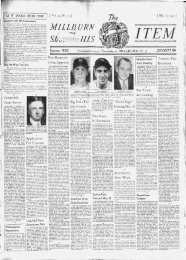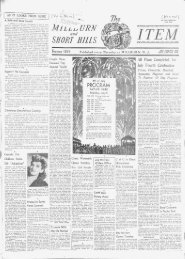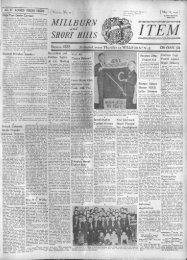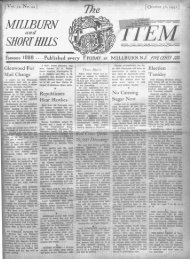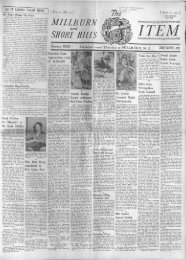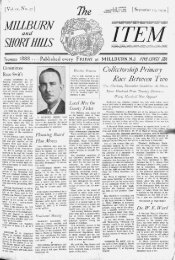24 - Millburn Public Library
24 - Millburn Public Library
24 - Millburn Public Library
You also want an ePaper? Increase the reach of your titles
YUMPU automatically turns print PDFs into web optimized ePapers that Google loves.
ki<br />
i<br />
ea<br />
Bt<br />
t*<br />
..!.if<br />
o?<br />
\<br />
SUBURBIA<br />
Life on a Ferryboat:<br />
Routine Is Essence<br />
Piloting a Ferry May Be Unexciting, But<br />
The Ride Is a Pleasant 'Extra' for Commuters<br />
By JOHN COAB<br />
A LTHOUGH the Lackawanna<br />
r\ railroad carries passengers<br />
from Buffalo, Oswego and Utica<br />
to New York, the tracks end. at<br />
Hoboken, a scant three-quarters<br />
of a mile as the sea gull flies,<br />
from their destination, Manhattan.<br />
In the intervening distance<br />
flows the Hudson river, ucitunneled<br />
and unbridged so far as the<br />
lackawanna is concerned, forcing<br />
the railroad to drop its passengers<br />
^and freight, so to speak,<br />
right at the water's edge almost<br />
within swimming distance of the<br />
city. The Lackawanna is not<br />
alone in this category. Also in<br />
the same bracket are the Jersey<br />
Central. Baltimore & Ohio and<br />
Erie railroads.<br />
This condition does not strike<br />
most travelers as particularly<br />
unusual. They simply board one<br />
of the ferries located at the stations'<br />
piers and for the next few<br />
minutes inhale the harbor<br />
breezes before plunging into the<br />
skyscraper canyons of the city.<br />
And rather thaei being a handicap,<br />
the ferries are an enjoyable<br />
"extra"' for thousands of commuters<br />
who get a water voyage<br />
included in the price of their<br />
monthly commutation ticket.<br />
Passengers who ride the ferries<br />
get a first hand view of the<br />
world's largest and busiest port<br />
in action. They see- all types of<br />
craft; chunky tugboats puffing<br />
their way busily about the harbor,<br />
sleek pleasure ya-chts, huge oceangoing<br />
liners, Navy cruisers and<br />
battleships, ugly, efficient freighters.<br />
It's a pleasant interlude<br />
after breakfast and just before<br />
plunging into the day's chores.<br />
The ferries which pick their<br />
way through this maze of harbor<br />
traffic day in, day out, fair<br />
weather or foul, have become as<br />
much a part of the m-etropolitan<br />
scene as Grant's Tomb, the<br />
Statue of Liberty or the Empire<br />
State building. And as an institution,<br />
if one way use that term,<br />
the ferry is at least a century and<br />
a half older than any of the aforementioned<br />
landmarks.<br />
The Hoboken Ferry, oldest on<br />
the Hudson, was started in 1775<br />
hy a Cornelius Harring. Early<br />
ferriea were rowboats or two<br />
masted canal boats, called perrangers,<br />
which carried passengers,<br />
animals and produce across the<br />
river according to an elaborate<br />
rate schedule. It wasn't until the<br />
early 1800's that the first steam<br />
ferry waa put into operation, and<br />
it was not until 1881 that the first<br />
steel-hulled ferry, the Lackawanna,<br />
was placed in service.<br />
Today the Hoboken Ferry,<br />
owned and operated by the Lackawanna<br />
railroad, owns nine boats,<br />
of which seven run Mondays<br />
through Fridays. Like most ferries<br />
they are not particularly<br />
beautiful craft and look like<br />
nothing so much as oversized<br />
match boxes scooting about the<br />
harbor. Their purpose is a functional<br />
one, not aesthetic. They do<br />
their job efficiently, without<br />
glamour or fanfare.<br />
An average day for a Lackawanna<br />
ferry consists of making<br />
18 round trips, during the day-<br />
Jight hours, between Hoboken"<br />
and New Tork. It takes a lit- Although the ferryman's life<br />
tle over five minutes for the isn't fraught with the dangers<br />
AUGUST <strong>24</strong>, r950<br />
Christopher street boat to make<br />
its run, S to 12 minutes for the<br />
Barclay street boat And the<br />
cause of inclement weather.<br />
The ferries are operated by the<br />
Marine Division of the Lackawanna<br />
with offices directly adjacent<br />
to the ferry slips. Superintendent<br />
of the Division m Captain<br />
F. H, Cog-an who has spent a<br />
good part of his life on the water<br />
and who holds a Master's license<br />
for all types of craff from ferries,<br />
to tugs, to ocean-going liners.<br />
Much of his professional life has<br />
been spent with the tugboat fleet<br />
and perhaps as a consequence of<br />
this he expresses no great enthusiasm<br />
about piloting a ferry.<br />
His fleet of nine boats has a<br />
carrying capacity of from 1200 to<br />
1500 passengers each end are<br />
operated by a crew of eight: a<br />
captain, a wheelsman, an engineer,<br />
a fireman and oiler, two<br />
deckhands and a porter.<br />
Some of the men who captain<br />
the ferries are almost literally<br />
bore into the profession, others<br />
take up the profession after experience<br />
on more adventurous<br />
type of craft.<br />
Oldest captain in the Marine<br />
Division's employ, from point of<br />
service, ia Captain William Cole<br />
of East Orange, who has been<br />
either working on or steering the<br />
beats since 1907. He more or less<br />
came by hLs profession through<br />
Inheritance. Both his grandfather<br />
and father were ferrymen in the<br />
New York harbor.<br />
For 53 years Cole has been<br />
sailing from one side of the harbor<br />
to the other. When people<br />
ask him if he ever tires of beating<br />
the same track year in and<br />
year out across the Hudson he<br />
sighs and says, "Yes, very." When<br />
he retires he thinks he will have<br />
had enough of water and boats<br />
and has turned down an invitation<br />
from, a friend to take a motorboat<br />
cruiae down the Inland Wa- -<br />
terway to Florida.<br />
The life of a ferry boat pilot is<br />
a comparatively quiet one. There<br />
are few mishaps, other than an<br />
occasional bruised bow, although<br />
once in a while some passenger<br />
may take it into his head to jump<br />
into the harbor. Life topside,<br />
however, is primarily clean, quiet,<br />
relatively unexciting.<br />
Below decks it's a different<br />
story. All of the Lackawanna's<br />
vessels, with the exception of one,<br />
are coal burners. Although life for<br />
the crew down below isn't exciting<br />
either, it's a warm one. Temperatures<br />
in the engine room<br />
hover almost constantly between<br />
110 and 120 degrees even though<br />
blowers give a certain amount of<br />
air conditioning. la this humid<br />
atmosphere the engineer, oiler,<br />
and fireman spend their working<br />
hours fueling and pampering the<br />
1,400 horsepower engines which<br />
propel the ferries. While the captain<br />
and wheelsman can enjoy<br />
the breezes and view from their<br />
pilot house, the crew below decks<br />
spend their hours completely cut<br />
off from the outside world except<br />
for the clanging bells which tell<br />
them to increase, decrease, stop<br />
or reverse the throbbing engines.<br />
and excitement which bis oceangoing<br />
brothers encounter, there<br />
there is excitement upon occasion.<br />
Captain Roy O. Wanvigr of New<br />
City, New York, can recall that<br />
three passengers have jumped<br />
overboard during his 32 years of<br />
service. The first customer to<br />
jump overboard had been having<br />
a disagreement with a fellow passenger.<br />
Upon being threatened<br />
with bodily harm he thought discretion<br />
the better part of valor<br />
and promptly jumped over the<br />
rail. The other two riders who<br />
took to the water were intent<br />
upon staying there permanently,<br />
but quick rescue work thwarted<br />
their intentions.<br />
Captain Wanvigr before becoming:<br />
a ferry captain acted as<br />
quartermaster and mate on ocean<br />
vessels, got his master's license<br />
while serving on a Standard Oil<br />
tanker. He likes his present job;<br />
doesn't get tired, he aaya, of going<br />
from one side of the river to<br />
the other all day long, and thinks<br />
he is a bit better off than some<br />
of his seafaring friends because<br />
he can get home to his family<br />
every night.<br />
Life on the ferries is routine,<br />
but according to Captain Herman<br />
Ahrens "when the weather is<br />
nice, time just fliee by and you<br />
don't mind it a. bit." He's been.<br />
steering- the boats since 1927 and<br />
when he retires he would like to<br />
spend his time cruising around<br />
the upper reache* of the Hudson<br />
in a power boat.<br />
As a rule the public causes the<br />
captain and the crew little trouble<br />
except for the over anxious commuter<br />
who attempts to tell tea<br />
skipper how to operate his boat.<br />
This unusually amiable relationship<br />
may seem a bit odd, particularly<br />
in view of the fact that tha<br />
•boats carry millions of passengers<br />
each year. But then, where else<br />
can the commuter get a eea voyage<br />
included in the price of a.<br />
commutation ticket. Even though<br />
ferries are slow by modern<br />
standards, many, no doubt, take<br />
pleasure in the thought that they<br />
don't at least have to speed<br />
through fume-filled tunnels on<br />
their way to work each day.<br />
A ferry starts on its trip across the harbor.<br />
A Piece. of Your Mind<br />
By KARL PLATZEK<br />
Psychologist<br />
LL of us deviate from tb*<br />
A so-called normal in some<br />
ways. We are taller or shorter<br />
than the average, "we weigh more<br />
or less, we have greater or leaser<br />
formal education. We feel more<br />
deeply or more shallowly, have<br />
anxiety about things or less. We<br />
have more physical energy or we<br />
tire more readily; we are more<br />
liberal in our views or more conservative.<br />
Within these wide area* of differences,<br />
however, we manage to<br />
keep up with life pretty well. A*<br />
problems arise, we may face them<br />
with, enthusiasm or with distaste<br />
and dread, but we face them. We<br />
may solve them easily or with<br />
difficulty, yet we solve them. The<br />
job we have to do may get done<br />
right away or later on, but sooner<br />
or later we do it<br />
This is a practical concept of<br />
adjustment to life. None of us has<br />
made a perfect adjustment to nil<br />
life, as the idea of adjustment L*<br />
commonly misunderstood. Indeed.<br />
it would be a very dull individual<br />
who did not have within him hia<br />
dissatisfactions, his rebellions, hi*<br />
hopes and ambitions, and his unsolved<br />
problems. But within that<br />
very wide area, from 85 to 90 per<br />
cent of us lead fairly useful lives,<br />
achieve some measure of success,<br />
feel reasonably happy, bring up<br />
pretty good children, and have our<br />
own. social group within which we<br />
are accepted.<br />
Wouldn't it be a duU world if<br />
all of us did conform, to the average?<br />
If we all thought pretty<br />
much alike, acted alike, had the<br />
same taste in food and tobacco,<br />
reacted in the same way, and voted<br />
for the same candidate, much of<br />
the zest would be gone from life.<br />
Yet in many waya, we are accepting<br />
just that idea. In our<br />
schools, for example, we have gons<br />
overboard on the idea that simple<br />
age is the great criterion. Regardless<br />
of stage of physical or mental<br />
ability, it ia accepted that a child<br />
miwt be five years old to be admitted<br />
to kindergarten, fourteen<br />
years old to be graduated from<br />
grammar school, and eighteen<br />
years old before he is mature<br />
enough to leave high echool. Parents<br />
who protest that their children<br />
are old enough to enter<br />
school be-fore five years of age<br />
are solemnly warned of the dire<br />
consequences that would eneu»<br />
should he be exposed to school influences<br />
at an earlier age. Tht<br />
perils of skipping a grade even<br />
though tha child is bored and<br />
restive at the slowness of hia<br />
work are taken as equivalent to<br />
an attack of smallpox. There is<br />
no evidence whatsoever that children<br />
come out of school under this<br />
system of forced conformance to<br />
an age average any better adjusted<br />
or better equipped to faca<br />
life than did those of an earlier<br />
generation, who started school<br />
when they were four year;* old<br />
and moat frequently were out of<br />
high school by the time they wer«<br />
sixteen.<br />
It is long past time that we<br />
stopped letting the statistical concept<br />
of normality and adjustment<br />
worry us. As individuals, w«<br />
and our children can differ very<br />
widely from our neighbors in attitudes<br />
and behavior, and still b»<br />
as normal ae normal should be.<br />
Fort Nonsense<br />
One of many interesting buildings<br />
and sites to be seen in Morriatown<br />
is Fort Nonsense, located<br />
on Western avenue, on a hill ba^<br />
hind the courthouse. The fort wai<br />
so named because it waa appar*<br />
ently built for no other purpos*<br />
•than to keep the soldiers of thf<br />
continental Army occupied during<br />
the winter. The old earthwork*<br />
have been reconstructed.<br />
Pag* 3



